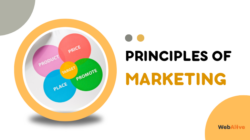
8 Proven Strategies to Fix Your Stale Ecommerce Online Marketing Strategy
Out the old and in with the new – this phrase couldn’t be more applicable to any other business than eCommerce. Be it the slow-moving stock or your eCommerce marketing strategy, things can always go in the wrong direction. That’s when you need to dip toes into the waters of new digital marketing strategies. And believe it or not, the pandemic only accelerated retail trends and eCommerce sales grew by 34.2% in 2020.
So, if you’re ready to roll up your sleeves and get to work, here are 8 strategies that you can follow to shake up your stale eCommerce digital marketing strategy.
Is your eCommerce marketing strategy not working? Run a check.
Before you read further, it is crucial to know the state of your eCommerce store’s marketing strategy. But, how do you know if it is working or not? Here are some of the common symptoms that you should look for.
- Assess Performance — The first step is to dig into analytics and understand whether your marketing efforts are working. Depending on your marketing goal, you may want to track and analyse key performance indicators like conversion rate, average order value, net profit and cart abandonment rate. If the desired numbers for these KPIs are baselining, that’s a telltale sign for your campaigns and marketing efforts.
- Understand Your Audience — Many eCommerce businesses suffer from attracting the wrong audience. They end up pulling in minnows despite having the intention to fish salmon. Is your business suffering from the same? Talking to your customers and understanding their motivations can be the game-changer in this case.
- Losing Leads — Losing leads isn’t uncommon for eCommerce businesses. But high numbers of ‘leads lost’ indicates the need for revamping marketing strategies. Under such circumstances, promotional efforts need to move towards informing and delighting potential customers.
Sounds familiar? Fix your eCommerce marketing with these 8 strategies.
If your business is suffering from one or more problems from the above, it’s time to fine-tune your eCommerce online marketing strategies. Here are 8 steps that you can adopt to explode sales for your eCommerce store.
1. Get the word out with referral marketing
Remember those days when they’d say — Just tell the cobbler my name, and he’ll take care of you. Gone are those days but the classic method of driving sales hasn’t changed.
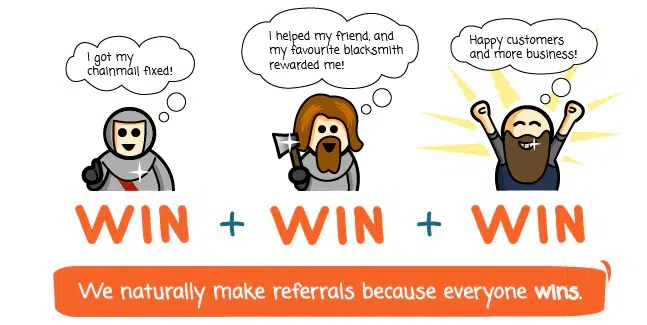
Source: Oberlo
Referral marketing, as the name suggests, relies on referrals — your existing customers recommending your products to their friends, family and network. Building an effective referral marketing program helps eCommerce businesses to acquire new customers and build a loyal customer base.
Now, why should your eCommerce business opt for referral marketing?
- Precision Targeting — Shoppers often reach out to acquaintances asking for products and services they recommend. This helps you to reach your target audience faster and that’s as precise as you can get.
- Trust — Did you know referral customers are four times more likely to buy? When your existing customers recommend a product, they also share their positive experiences with the brand.
- Increased Reach — Referral marketing increases the reach of your brand and has the potential to convert visitors into paying customers. According to Saasquatch, 14% of visitors reaching the referral page will take action.
An example of an eCommerce referral program is the Australian online beauty store Adore Beauty – which gives customers a $10 reward for promoting the brand to their friends.
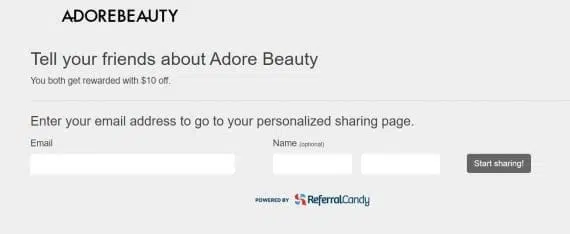
Giving the right incentive and promoting your referral program is key to success. Hyphen, an ecommerce sleep solution company, runs a referral program to help existing customers refer potentially interested customers.
2. Generate valuable leads with Instagram marketing
With 1.16 billion active users every month, Instagram is the perfect place to showcase products, garner feedback, and reach potential customers. But, how do you use Instagram marketing to convert your eCommerce store into a sales machine? Here’s what you need to focus on:
- Growth hacking — Besides putting up posts (conversational and promotional), you need to figure out what is working for your brand. Start with relevant hashtags that help you connect with customers who have similar shopping interests. Once you have enough followers, you can also run contests and focus on user-generated content.
- Pay attention to analytics —Instagram analytics shows you the hours when followers are active and the kind of posts that get more interactions.
- Recruit influencers — With celebrity shout-outs and influencers, you can get incredible engagement and that’s what you should target to get your brand off the feet. Influencer marketing is a great way of co-partnering with an influencer whose audience is similar to the users you are targeting.
An example: Dunkin’ Donuts teamed up with nano influencers when they decided to target a younger and digital-centric generation. The goal was to reach an authentic audience and boost their engagement rate. As a result of the campaign, Dunkin’ Donuts reached 1.1 million Instagram followers, generated 21.975 likes and over 900 comments from 25 posts. Great results, right?

3. Meet sales targets with Facebook ads
Want highly relevant traffic and more conversions? Running Facebook ads can help you to meet both and increase repeat sales as well. So, what kind of Facebook ads should you run?
- Dynamic product ads — Want to showcase tailored ads to hesitant customers? With dynamic product ads, you can show customised ads based on user activities on the website. This helps you to retarget visitors who need an extra push to make the purchase.
- Carousel ads — In the eCommerce industry, carousel ads where the user can scroll through a series of ads are a great choice. They help you to showcase multiple products in a single ad and offer customers the flexibility to choose. The key here is to show ads relevant to what the customer has been looking for. Relevant products increase the chances of conversion in such cases. Fashion brand Modcloth uses carousel ads to show their product range.
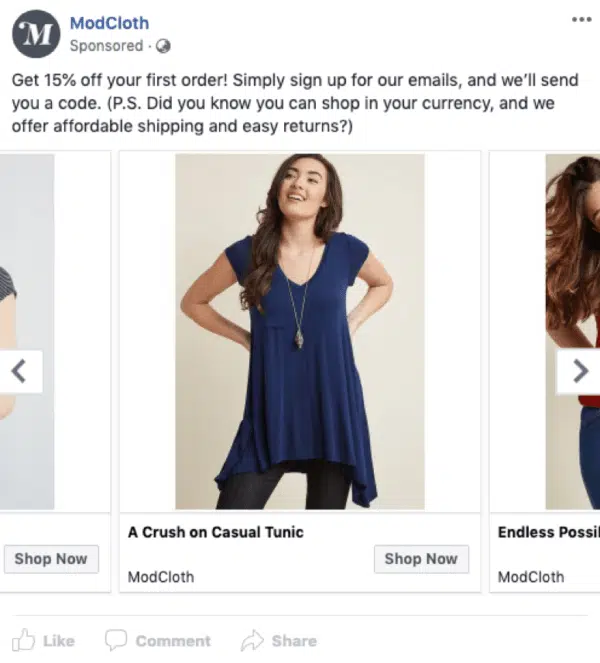
- General retargeting campaigns — Did you know that the average cart abandonment rate stands at 69.57%? You can target them with general retargeting display ads to increase conversion.

Source: ShortStack
Here is an example of Facebook ads run by Ralph Lauren. Facebook ads work best when you showcase stunning images with faces and showcase clear value propositions.
4. Jazz up your social media marketing with memes
Marketers know that consumers skip ads wherever they can. In such a time, marketing with humour and familiar media is one way to engage Hard-to-reach consumers. For business owners, marketers and storytellers, meme marketing is a low-cost way to create engaging content that attracts attention.
Memes can even take the form of GIFs or static pictures playing on a familiar theme, meaning or phenomena. On social media, they are often layered with text over the image, on top or below.
Across industries and in eCommerce, marketers are using memes to relate to their audience, build a community and create brand awareness.
Here is why meme marketing should be a part of your social media content strategy.
- Memes are inexpensive to create.
- Memes support a sense of community.
- Meme-based content gets more shares to help your eCommerce brand reach an even wider audience.
- Memes make your brand more real, modern and relatable.
Here’s an example of how clothing retailer brand ASOS did it on the eve of thanksgiving.
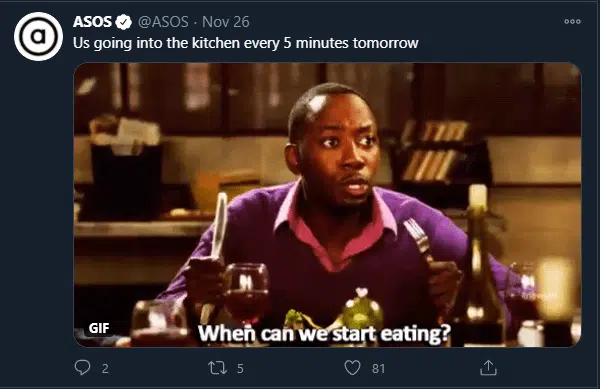
A tool like the InVideo meme generator can help you turn a memorable image into a viral theme in minutes. You can use your own videos or stock images, add meme text and it is ready to share.
5. Convert one-time purchases into subscriptions with upselling
Marketing to one-time buyers to sign up for subscriptions isn’t easy. As an eCommerce business, you should adopt upselling as a part of your eCommerce marketing strategy to address this challenge. For example, you can offer a member price on product pages and show customers will actually save money by opting for it.
Here’s an excellent example of how MeUndies does it to increase customer retention.
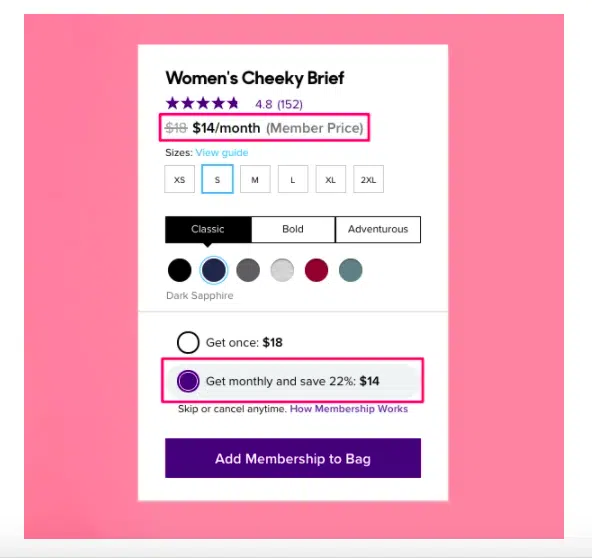
Source: SleekNote
Now, convincing buyers to opt for subscriptions isn’t easy.
Here are a few tips to nudge your visitors to upgrade to a subscription.
- Big return on investment — Your customers already know that subscriptions will probably offer more value. But you have to show that to them at every step in order to make them commit to it.
- Appeal the rational mind — Are you selling products that people need to refill or restock regularly, such as men’s razors and shaving kits? In such cases, you may be better off by showcasing the benefits they will get from signing up for the subscription.
- Give the ultimatum — Can you watch a single movie on Netflix without paying the subscription fees? No, right! You may want to create a segment of products that are only available to those opting for a monthly subscription.
6. Convert wishlists with a gentle nudge (Think of discounts)
Your buyers may add items to wishlists and then simply forget about it. As an eCommerce business, it’s upon you to go all out in the pursuit of converting that wishlist into a paying order. One way of doing it is to send reminder emails with a clear call-to-action (CTA). But, what are the other ways around it?
- Encourage wishlists — The first step is to encourage visitors to create wishlists. Make it super easy for registered users and allow new users to create the same with an email id.
- Ongoing reminder — Be it emails or pop-ups, you need to constantly remind your users about the wishlist they created.
- Exclusive discount — You can also introduce a wishlist exclusive discount with terms and conditions to motivate potential buyers and encourage them to take action.
Here’s how Chairish an online home furnishings store encourages visitors to create a wishlist in the first place. When I create an account on the Chairish website, this welcome email asks me to find my favourites. The motivation? They will notify me when my selected items go on sale.
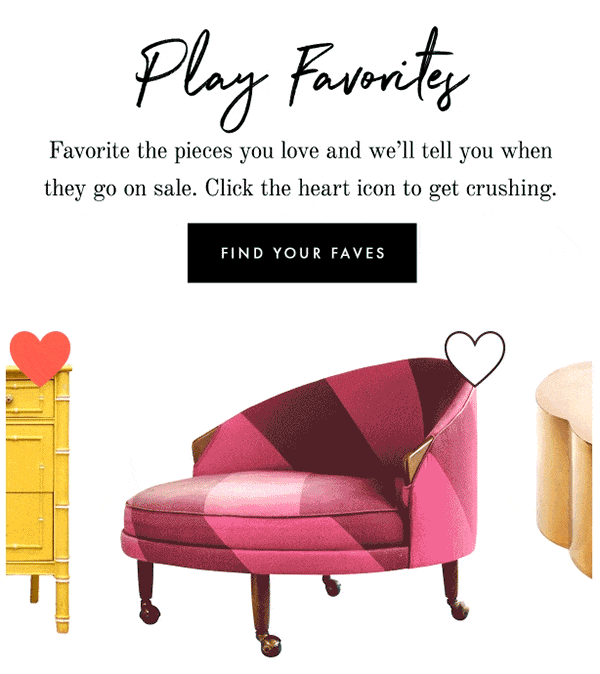

This way I have a good reason to start a wishlist and I’m more likely to buy a product when it goes on sale.
Using segmentation and the customer data you’ve collected using a CRM such as EngageBay CRM, you can send targeted emails based on the buyer’s journey.
7. Drive conversion with social proof in emails
One of the most successful eCommerce strategies is to use customer testimonials in your emails. Potential buyers prefer to hear from people who have already purchased and experienced the product. While many showcase such testimonials on product or landing pages, you can also use them in emails.
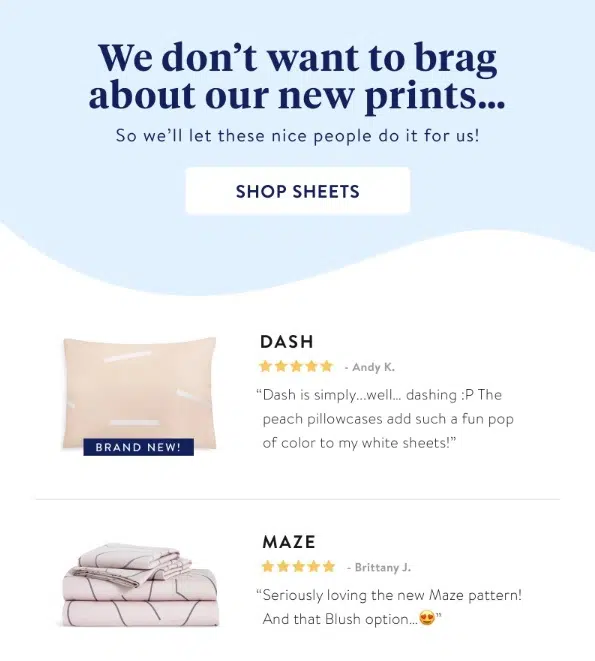
Source: SleekNote
Here’s an example of how BrookLinen, the NY-based home-essentials brand does it. Instead of adding product descriptions, they let customer reviews do the talking.
Here’s how to use social proof in emails:
- Customer testimonials — Select a few customer testimonials from your website and place them while creating the email marketing campaign.
- Product details — Along with the review and the product image, try adding the price information and purchase links.
You can even add customer testimonials in promotional emails. After all, who else can describe your product better than a customer!
8. Combine free shipping and FOMO to sell more
Offering free shipping beyond an order value helps you to increase sales and average order value (AOV). In fact, 93% of online shoppers would actually buy more when there is a free shipping option available.
For your eCommerce business, you can trigger prospective customer’s FOMO (fear of missing out) – to nudge them to spend more and qualify for free shipping.
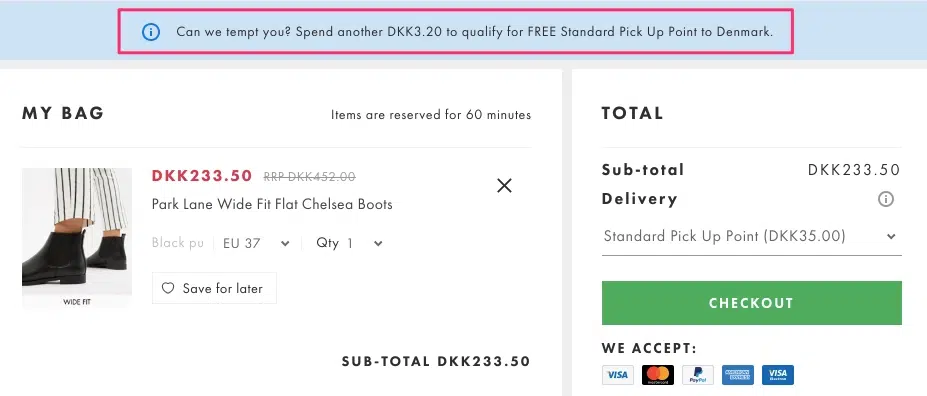
Here’s how ASOS implements this strategy to sell more. Nudging customers at every step before they make the payment is the best way to go about it.
If you want your bottom of the funnel (BOFU) prospects to spend more, here’s how you can recommend products they can quickly add to the cart.
- Remind customers they will miss out on the free shipping unless they spend more.
- Be clear about the minimum amount required to qualify for free shipping. For example, “You are only X dollars away from free shipping.”
- Integrate with dynamic recommendations while creating free shipping campaigns.
Conclusion
You don’t require a complete website revamp to boost sales and conversions. If you need some fresh ideas for your eCommerce marketing success, give these strategies a chance and find out what works the best for your business.
You read a lot. We like that
Want to take your online business to the next level? Get the tips and insights that matter.

